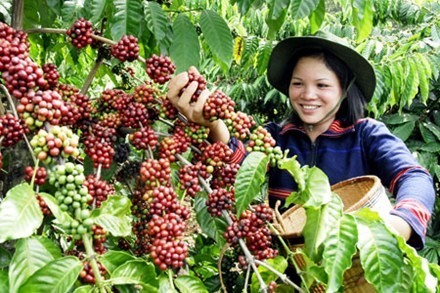 Economy
Economy

The coffee industry is restructuring itself to raise productivity, quality and value, according to the Việt Nam Coffee and Cocoa Association.
 |
| A farmer harvests coffee in Central Highland region. The coffee industry is restructuring itself to raise productivity, quality and value, according to the Viet Nam Coffee and Cocoa Association. — Photo giaoduc.net |
HCM CITY — The coffee industry is restructuring itself to raise productivity, quality and value, according to the Việt Nam Coffee and Cocoa Association.
Under the programme, the area under coffee is being kept at 600,000ha and there is a focus on planting new trees with higher productivity and quality, Lương Văn Tự, the association’s chairman, said.
The industry would work to increase exports of processed coffee to achieve revenues of US$5-6 billion by 2030, he said.
That would mean increasing the ratio of processed coffee from the current 10 per cent to 30-40 per cent.
Speaking at a seminar titled “Future Development of Việt Nam Coffee Industry towards 2030” on Firday, Đoàn Xuân Hòa, former deputy director of the Department of Processing and Trade for Agro-Forestry-Fisheries Products and Salt Production, said the coffee industry has developed strongly in the last 10 years, exporting 1.2-1.5 million tonnes worth $1.7-1.8 billion a year and accounting for 15-20 per cent of the country’s agricultural exports.
Việt Nam is the world’s second largest coffee exporter and leads the world in robusta production and export. But the exports remain in the form of unprocessed beans with little value addition.
The industry is facing several problems like small scale of production, ageing coffee trees, poor quality control, and outdated processing technologies.
Some 140,000-160,000ha need to be replanted in the next five to 10 years, a big challenge for the industry, he said.
Lê Văn Đức, deputy head of the Crop Production Department, said in 2014-15 the five Central Highlands provinces of Lâm Đồng, Đắc Lắc, Đắc Nông, Gia Lai, and Kon Tum, the main coffee growing areas, worked to replant more than 61,700ha.
The figure is expected to reach nearly 80,000ha this year, he said.
Trương Hồng, director of the Western Highlands Agriculture and Forestry Science Institute, said new coffee varieties play an important role in ensuring Việt Nam’s coffee industry develops sustainably.
The new varieties help improve yields, quality and economic efficiency, and increase the co-efficiency of using water and fertilisers and protect the environment, he said.
Delegates at the seminar proposed several measures for the industry to develop in a sustainable manner, like investing in processing technologies to add value to coffee products and developing linkages between producers and processing companies.
Local authorities should review coffee zoning plans and switch crops where productivity is poor, Hòa said.
The industry’s sustainable development would require more financial support and credit policies from the Government, he said.
According to the International Coffee Organisation, the bean requires relatively specific climatic conditions to thrive.
As the world heats up and extreme weather events become more frequent, these specific climatic conditions are likely to become more scarce, it said.
These developments would require countries to implement co-ordinated mitigation and adaptation strategies to continue producing quality coffee, it said.
This is an issue that needs to be tackled jointly to ensure that coffee remains a viable crop, it said.
This is why it is so important for countries to plan ahead, and to have a strategy for sustainable coffee production in the long term, it added. — VNS




